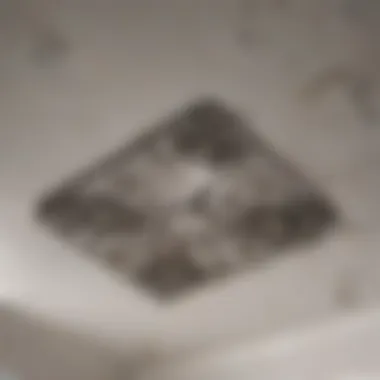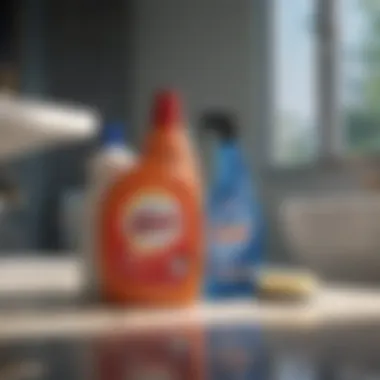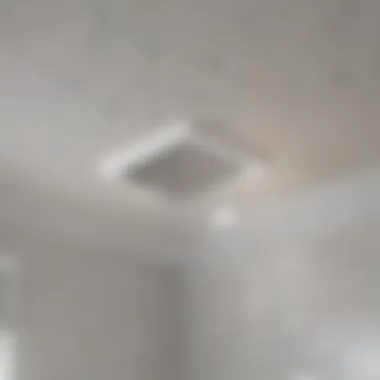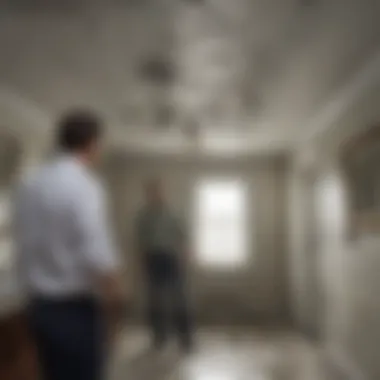A Complete Guide to Tackling Moldy Bathroom Ceilings


Intro
Mold in bathrooms is a frequent yet pressing issue that many homeowners face. The humid conditions combined with less ventilation create the ideal space for mold spores to flourish. Recognizing the signs of mold is the primary step before embarking on a plan to remediate the situation effectively. In this guide, we will provide a comprehensive understanding of how to approach a moldy bathroom ceiling, discussing material requirements, step-by-step cleaning methods, precautions to maintain a healthy home, and the steps that might require professional intervention.
Materials:
To start with, proper planning is essential. Below are the materials that you will need to address a moldy bathroom ceiling thoroughly:
- Bleach: 1 quart (for severe mold cases)
- Mold cleaner: 1 quart (unless preferring a homemade solution)
- Water: 1 gallon (doing this for dilution)
- Scrub brush: 1 medium sized
- Sponge: 2 piece (soft)
- Safety mask: 1 (N95 or similar)
- Rubber gloves: 1 pair
- Plastic sheeting: sufficient enough to cover floor and fixtures
- Bucket: 1 (for mixing solution)
- Spray bottle: 1 (for easy application)
- Old towels or rags: several, depending on mold severity
- Paint: specialized anti-mold paint (optional, for finishing touches)
DIY Steps:
When addressing a moldy bathroom ceiling, follow these detailed steps:
- Safety First: Before beginning, wear safety gloves and a mask.
- Clear the Area: Move any items below your work area, such as toiletries and towels.
- Cover Fixtures: Use plastic sheeting to cover fixtures and furniture you do not want to damage.
- Prepare the Solution: If using bleach, dilute 1 cup of bleach in 1 gallon of water. For mold cleaner, simply follow the product’s pressing instructions.
- Application: Use the spray bottle to apply your cleaning solution onto the moldy areas. If using bleach, ensure good ventilation. Allow the solution to sit for about 10-15 minutes.
- Scrubbing: With a scrub brush, gently scrub the affected area. Take care not to damage the ceiling surface.
- Rinsing: After scrubbing, dip a sponge into clean water and go over the area to remove residue of the cleaning solution.
- Drying: Use old towels to absorb extra moisture. Ensure the area dries completely to minimize the chance of regrowth.
- Optional Paint Application: If desired, apply a coat of anti-mold paint as ythe finishing touch.
Technical Aspects:
Several tools are essential for doing the job well, and understanding the correct timing for each step will yield optimal results:
- Tools Needed:
- Time Specifications:
- Critical Techniques:
- Scrub brush
- Spray bottle
- Sponge
- Bucket
- Safety preparation: 10 minutes
- Cleaning time: 30-40 minutes
- Drying process: 1-2 hours
- Optional painting: 2-4 hours (drying time included)
- Begin cleanup from the top and work down, avoiding droplet contamination.
Always prioritize well-ventilated spaces to reduce your risk of exposure to mold spores.
Troubleshooting Tips:
As you proceed, common challenges may arise. If you run into difficulties:
- Stains Remain: For persistent stains, you might want to apply the cleaning solution again or switch to a more potent cleaner.
- Worsening the Mold: If mold seems to spread, this could mean it's harboring behind the surface. In such cases, consultation with professionals might be prudent.
Understanding Mold Growth
Mold growth in bathrooms poses significant health concerns and can damage the structure of the home. Fir slab, to effectively address a moldy ceiling, it is vital to first understand the nuances of mold growth. Awareness of the conditions that facilitate mold proliferation allows homeowners and housewives alike to take timely action before extensive damage occurs.
Mold thrives in damp, humid environments, and bathrooms often fit this description perfectly. The moisture from steamy showers and baths creates an ideal breeding ground. Considering the rapid speed at which mold can grow gives further reason to act promptly when identifying and treating mold-related issues.
Moreover, understanding the specific types of mold that may inhabit bathrooms informs effective treatment strategies. Certain molds, like Stachybotrys chartarum or black mold, are particularly harmful and require immediate professional intervention. Not all molds have identical growth conditions; thus comprahending their specific needs is important.
The Science Behind Mold
Mold, a type of fungus, reproduces through tiny, airborne spores. These spores can travel through air easily, finding new environments to colonize. When they settle in a place with optimal moisture, temperature, and organic material, they can germinate and grow quickly.
The moisture level is key. For mold to persist, a relative humidity above 60% is often necessary. The temperature range ideal for mold typically falls between 70 to 90 degrees Fahrenheit. Common organic materials found in homes, such as wood, paper products, and even dust, can serve as sustenance for mold, further complicating the issue.
Properly addressing a mold situation comes from an understanding of these scientific principles. Homeowners need not only to focus on removing mold but also to prevent its return by eliminating the conditions that support growth.
Common Causes of Mold in Bathrooms
Several factors contribute to mold presence in bathrooms. Identifying these common causes is essential to direct your cleaning efforts effectively:


- High Humidity: Bathrooms create hot steam, particularly during showers.
- Inadequate Ventilation: Lack of windows or ventilation fans can fail to dispel moist air.
- Water Leaks: Minor leaks from faucets or hidden pipes can provide a consistent moisture source.
- Poor Insulation: Areas of poor insulation can lead to cold spots on the ceiling or walls, activating mold triggers.
- Damp Towels or Rugs: Failing to dry wet items promptly favors moisture retention.
Addressing these underlying issues heads off additional mold problems before they gain a foothold. Educating oneself on the causes allows everyone to implement preventative measures to keep the bathroom healthy and clean.
Identifying Mold on the Ceiling
Identifying mold on the ceiling of a bathroom is a vital step in addressing the issue of mold growth. Early detection is essential for managing mold's impact on your health and home. Mold can cause respiratory issues, allergies, and other health problems, especially in vulnerable populations such as children or the elderly. This section will explore the visual cues and types of mold found in bathrooms, equipping you with the knowledge to respond effectively.
Visual Signs of Mold Growth
Recognizing the visual signs of mold growth begins with understanding the conditions that promote mold. Look for dark spots or stains that can range from black to greenish-brown. If you notice areas that appear fuzzy or have a residue that is slimy, these can signal mold presence. Other indicators may be varying shades or patches that do not conform to the ceiling's original color. These spots often thrive in locations that experience warmer temperatures and high humidity, such as in corners or around ventilation ports.
It's equally important to conduct a thorough inspection post-cleaning. Sometimes, mold growth can recur if all remnants are not successfully treated. Additionally, you should check behind fixtures or in anyone highly humid areas. These might not be visible at first glance but could harbor mold effectively. Detecting mold really early protects both your ceiling integrity and your well-being.
Always be alert for signs of mold. Early intervention prevents further damage.
Identifying Different Types of Mold
In bathrooms, various types of mold may emerge. It's useful to distinguish these molds, as specific types can indicate different levels of severity. The common mold types in bathrooms include:
- Aspergillus: Generally green or black, this mold tends to thrive in humid conditions. It's noted for being fast spreading.
- Cladosporium: Found in damp places, this type can appear black, green, or brown. It sometimes is itchy when spores disperse.
- Stachybotrys chartarum: Known as black mold, this one is slower to develop but is the most hazardous to health bouts – causing severe allergic reactions.
Differentiating between types of mold on your ceiling sets a clear path for treatment and recovery planning. Knowing the risks associated with each dense tailors your approach, ensuring both safety and effectiveness when removing mold.
Everyone should take this aspect seriously. Recognizing mold promptly equates to both health benefits and preservation efforts for your household spaces.
Safety Precautions for Mold Removal
Removing mold from a bathroom ceiling is a task that requires careful considerations to ensure safety. Mold can cause health problems if not addressed correctly. Safety precautions before and during the removal process will help protect homeowners and their families from health risks. Understanding these safety measures is crucial for a successful mitigation.
Protective Gear Recommendations
Before starting work on a moldy ceiling, several pieces of protective gear are recommended to minimize exposure to mold spores. Wearing proper gear significantly reduces the risk of inhaling harmful particles.
- N95 Respirator: This mask filters out most airborne particles, providing reliable protection.
- Goggles: Safety goggles help to protect the eyes from mold spores and any cleaning chemicals you may use.
- Gloves: Rubber or latex gloves are essential to protect skin from irritants and mold spore contact.
- Old Clothes: It is advisable to wear clothes that you do not mind possibly discarding afterward. Mold spores may cling to fabric and become a spread issue if not contained.
Equipping oneself with the right gear creates a first defense against potential health hazards related to mold exposure.
Ventilation and Airflow Considerations
Ensuring proper ventilation is a vital safety aspect when addressing the removal of mold. Increased airflow reduces the concentration of mold spores in the air. Here are vital points to keep in mind:
- Open Windows: If feasible, open windows during the cleaning process. This fresh airflow helps disperse airborne spores.
- Exhaust Fans: Use bathroom exhaust fans to improve ventilation. If the fan is not functioning adequately, upgrading might boost efficient airflow.
- Dehumidifiers: Utilizing a dehumidifier not only helps minimize mold growth but also promotes acceptable humidity levels during the removal.
Proper ventilation is a key part of safety during mold cleanup. Ignoring this step can lead to respiratory problems and other concerns.
Safe mold removal involves a careful balance of protective measures and environmental considerations. Taking these precautions creates a safer space for the homeowner to work and diminishes the chances of further problems during and after the cleaning process.
Cleaning Mold from the Ceiling
Cleaning the mold from your bathroom ceiling is more than just an aesthetic issue. Mold can contribute to several negative effects on health and home structure. Eliminating this unsightly and potentially harmful growth ultimately supports a healthier living environment.
Effective cleaning can minimize allergies, respiratory issues, and other related health risks. Moreover, preventing a recurrence can save homeowners time and money in the long term.
Preparing the Cleaning Solution
Before tackling the mold trouble on your ceiling, you need a suitable cleaning solution. The effectiveness of your approach relies heavily on the type of products utilized. Commonly used options include diluted bleach, vinegar, and specialized mold removers like Trader Joe’s Lemon Fresh Pledge or CleanSmart Daily Surface Cleaner.


When making a cleaning solution:
- Dilution is key: If you choose bleach, mix one cup of bleach to a gallon of water.
- Natural alternative: For vinegar, you can use it undiluted in a spray bottle for a more intense effect.
Test on a small area first to ensure that the ingredients will not damage your ceiling paint.
Step-by-Step Cleaning Process
Follow these steps for cleaning the mold from your ceiling effectively:
- Safety First: Put on gloves, goggles, and a mask to protect yourself from spores and cleaning agents.
- Prepare the area: Place drop cloths on the floor to catch any debris and protect the surrounding area.
- Apply the cleaning solution: Use a sponge or soft cloth to apply the cleaning mixture directly to the affected area. Spray generously, allowing it to soak in for about 10-15 minutes.
- Scrub the mold: Using a brush, scrub the area gently. Be aggressive, but stay mindful of the ceiling surface so it does not weaken or chip.
- Rinse the area: Wipe with clean water on another cloth to remove any residue from the cleaner. This helps keep your bathroom safe from harsh chemicals. This step is especially important if you have children or pets at home.
- Dry the area thoroughly: Increase airflow using fans or open windows to ensure any remaining moisture evaporates quickly. Excess moisture promotes more mold growth.
Post-Cleaning Inspection
After cleaning, a thorough post-inspection technique is crucial to ensure that all molds are effectively eliminated, and no areas were missed. Here’s what to check:
- Visual check: Look closely for any remaining dark spots or discoloration.
- Smell test: Ensure there is no lingering musty odor, which could indicate retained spores.
- Touch: Run your hand over the previously affected area to determine if there's any residue. Proper cleaning should leave it smooth.
If needed, repeat the cleaning process on stubborn spots. Doing this right goes a long way to secure a continually healthy environment.
" Regular inspection can help you catch problems early, saving time and effort later on. "
Repairing Damaged Areas
Repairing damaged areas in a bathroom ceiling is a crucial part of managing mold growth. Addressing these repairs promptly can prevent complications and further mold infestations. Damaged areas can signal an underlying problem, which, if ignored, may lead to structural issues over time. Thus, not only does repair improve aesthetics, but it can also restore the integrity of the ceiling and prevent health hazards associated with mold exposure.
Assessing Ceiling Damage
Before any repairs can be made, it’s essential to assess the extent of the damage done to the ceiling. This involves a thorough examination of any visible stains, discoloration, or bubbling. Here are key points to consider during assessment:
- Visual Inspection: Look closely to locate spots that are affected by moisture. Notice any discoloration that suggests water damage or mold presence.
- Texture Examination: Check if the ceiling feels soft or spongy. A compromised texture indicates significant damage that may need more extensive repair.
- Moist Probability: Investigate the source of moisture contributing to the damage. Addressing moisture source is critical to preventing re-occurrence.
It may be helpful to document any findings for future reference or guidance. Ensuring that you have the right understanding of what is damaged is paramount before proceeding.
Choosing the Right Repair Materials
Selecting appropriate materials for repairs decides the effectiveness and durability of the work. Here are some important guidelines:
- Determine the Surface Type: Identify what type of ceiling materials are present. For instance, drywall needs different treatment than paint or plaster.
- Mold Resistant Options: Opt for mold-resistant materials, such as special drywall or ceiling paint that help inhibit mold growth subsequently.
- Sealants: Choosing an effective sealant can prevent moisture infiltration. This can greatly reduce the likelihood of mold returning post-repair.
A solid understanding of material types and their applications will facilitate an effective repair process, producing satisfactory results for longevity.
Applying Repairs Effectively
Once the damage has been assessed and materials are selected, applying these repairs correctly is vital. Here is a step-by-step guide:
- Prep the Area: Remove any furniture or items near the application area to avoid contamination during the repair.
- Clean the Surface: Use a wire brush or sandpaper to eliminate all mold during cleaning. Wipe it down with a damp cloth and allow it to dry fully before proceeding.
- Apply Replacement Material: If drywall or panels were compromised, cut and fit new pieces where necessary. Utilize appropriate adhesives and screws as needed.
- Finish with Primer and Paint: Once the new material is in place, factor in a primer that combats mold and then apply at least two coats of mold-resistant paint.
- Inspect and Document: Finally, post-repair inspection is essential. Verify the job was done well and minsure all materials are appropriately secured.
Remember, proper repair is fundamental. Neglecting it might lead to future headaches concerning mold reappearance and structural inconsistencies.
By effectively repairing as instructed above, one can significantly diminish risks tied to mold, ensuring that the bathroom remains a safe and healthy environment.
Preventing Future Mold Growth
Preventing mold growth is crucial for maintaining a healthy bathroom environment. Once mold has taken hold, it can be damaging to both your home and your health. Mold spores are a common allergen, and exposure can lead to various health issues, like asthma or allergy flare-ups. By focusing on preventive strategies, homeowners and housewives can minimize the likelihood of mold returning once the initial problem has been addressed.


Enhancing Bathroom Ventilation
Adequate ventilation plays a significant role in mold prevention. Bathrooms are naturally humid environments, and without proper airflow, moisture can become trapped, creating ideal conditions for mold to thrive.
- Install Exhaust Fans: An exhaust fan is a valuable tool in reducing humidity levels. Aim to run the fan for at least 30 minutes after showering or bathing. This will help to expel moist air and draw in drier air.
- Open Windows When Possible: Introducing fresh air can make a difference. During dry weather, consider opening the window during and after bathing to facilitate excess humidity release.
- Use Dehumidifiers: If your bathroom lacks adequate ventilation, employing a portable dehumidifier can assist in moisture control, particularly in more humid climates.
Regular maintenance on ventilation systems ensures they function properly. A clogged exhaust fan can reduce its effectiveness, leading to stagnant air and increased moisture.
Regular Maintenance Practices
Consistency in maintenance is key to a mold-free bathroom. Establishing regular habits can significantly reduce the chance of mold returning or taking hold. Consider the following practices:
- Clean Regularly: Regular cleaning can help to remove any mold spores before they multiply. Use a mold-inhibiting cleaner on tiles and other surfaces prone to mold accumulation.
- Inspect for Leaks: Leaky faucets or pipes can contribute to excess moisture. Check these regularly and address any issues promptly.
- Caulk and Seal: Ensure that all seams, particularly around bathtubs, toilets, and sinks, are properly sealed. Over time, caulk can wear away, making it easier for moisture to seep through and mold to develop.
Considerations for Bathroom Design
Design choices can influence moisture levels and mold susceptibility in a bathroom. When creating or renovating a bathroom, take potential mold growth into account:
- Materials Matter: Choose mold-resistant paints and materials, such as tile or fiberglass, that do not retain moisture. Natural materials like granite or quartz may also have benefits.
- Opt for Easy-to-Clean Surfaces: When possible, select surfaces that can be easily cleaned to minimize mold-friendly spaces. A bathroom should inherently be designed for durability and ease of maintenance.
- Layout: Increase airflow by considering the layout during the planning stages. Avoid placing shower stalls in corners where air cannot circulate.
Taking these preventive measures not only helps maintain a healthier bathroom but also prolongs the longevity of your spaces. Being proactive in ventilation, maintenance practices, and design shows forethought and care for the home. Employing these strategies will help in embracing a mold-free environment for all.
When to Consult Professionals
Dealing with mold in a bathroom ceiling can sometimes be manageable at home. However, there are instances where it is prudent to consult professionals. Knowing when to seek help can ensure that the problem is handled effectively and your health is protected.
Mold mismanagement can lead to health hazards.
Assessing the Extent of the Problem
A professional assessment can provide crucial insight into the mold issues at hand. It is essential first to recognize whether the situation is beyond what basic cleaning can resolve. Significant factors in assessing extensiveness include:
- Size of the affected area: If mold spans more than a few square feet, expert guidance is advisable.
- Hidden mold: Mold behind walls or under ceilings can remain undetected at first. Professionals use tools like thermal imaging and moisture meters to find these issues.
- Water sources: Persistent moisture issues often indicate deeper problems requiring special evaluations, such as plumbing leaks or insufficient ventilation.
Confirming these aspects through expert assessment not only identifies the problem but also aids in preventing possible reoccurrences.
Choosing the Right Mold Remediation Expert
Once you recognize the need for professional help, you must select the right expert for mold remediation. Not all service providers are the same. When searching for a qualified worker, consider the following:
- Credentials and certifications: Ensure the hired individual has reputable certifications in mold removal. Look for RDC (Registered Mold Remediation) and IIRC (Institute of Inspection, Cleaning, and Restoration Certification).
- References and reviews: Investigate past projects through online reviews or personal references to gauge a professional's competency.
- Approach to the problem: Different professionals choose varied strategies for addressing mold. Speak as well about the methods they employ before making a final decision. Having proper techniques can significantly reduce mold regrowth.
Choosing a qualified professional can seem daunting, yet it guarantees that the underlying issues are systematically addressed, consequently securing your living space healthily in the long run.
Epilogue
In addressing a moldy bathroom ceiling, the conclusion serves as a pivotal recap of the entire process. Comprehension of the critical steps discussed through the article ensures that homeowners can tackle mold issues effectively and prevent their recurrence. Engaging with this guide has revealed multifaceted strategies that cater to immediate rectification and sustained maintenance.
Summary of Key Steps
Ultimately, the journey involves several essential steps, including:
- Thorough identification of mold through visual indicators and careful consideration of bathroom conditions.
- Taking appropriate safety measures, such as using the right protective gear and ensuring proper ventilation which is crucial for your well-being while dealing with mold.
- Efficient cleaning strategies, complete with suitable cleaning solutions tailored to effectively eliminate mold while being mindful of the ceiling's material.
- Proper assessment and repair of any damaged areas to ensure lasting solutions.
- Implementing prevention techniques, including enhancing airflow and maintaining regular inspections to outsmart any future outbreaks of mold.
- Knowing when to reach out to experts when the mold issue is beyond DIY capability.
These steps form the backbone of effective mold management. You must see them as an interconnected series of actions rather than isolated tasks. Taking these actions can establish a sustained healthy bathroom environment.
The Importance of Regular Maintenance
Maintaining a mold-free bathroom space requires more than just proactive measures during an outbreak. Regular maintenance becomes a cornerstone of your hygiene routine and health. By engaging in consistent upkeep:
- Routine inspections of your bathroom can pinpoint developing mold issues before they become severe.
- Cleaning fixtures and surfaces frequently to eliminate the moisture from residues can inhibit mold growth remarkably.
- Utilizing adequate ventilation, through exhaust fans or open windows post-shower, keeps the room dry and inhospitable to mold spores.
- Considering age and material of bathroom constructions can guide reflections on necessary upgrades, ensuring environments are conducive to mold prevention.
Integrating these practices into your schedule encourages a cleaner space. Understanding their significance means your effort translates to avoiding costly repairs or unsanitary conditions in the long run. Thus, the connection between regular maintenance and effective mold management cannot be overstated.







